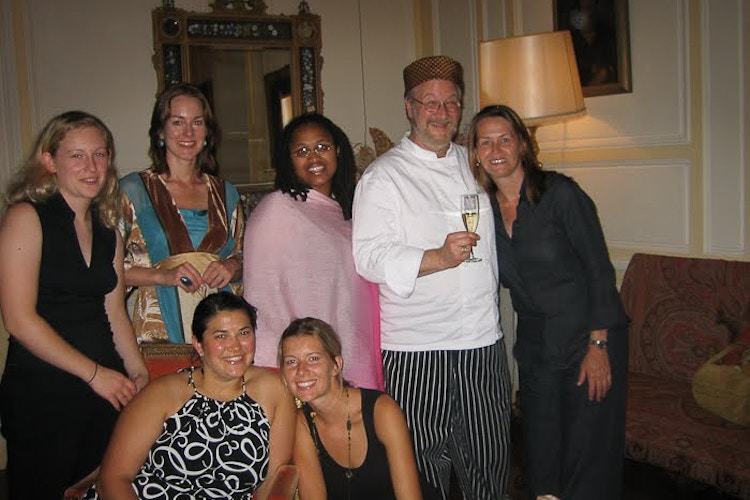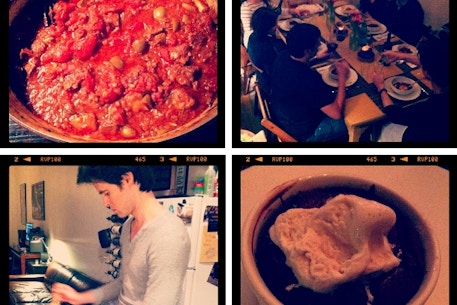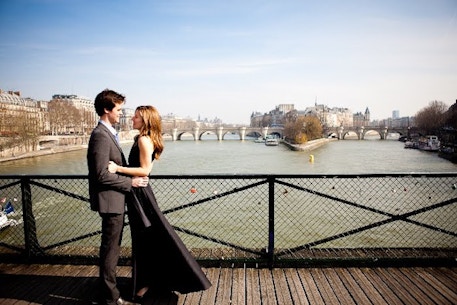Q&A with Chef Randall Price
To say Chef Randall Price has led a fascinating life would be an understatement. This incredibly talented chef, writer, and teacher has cooked for presidents, diplomats, and royalty – in embassies, chateaux, and restaurants – and has written a book and a comic book series about (some of) his experiences. American-born, Randall has lived in France for 26 years, and he can thank Eagle Brand condensed milk for getting him over there for the first time (read on for details).
I had the privilege of meeting Randall in 2006 when I was a stagiaire ("trainee") at La Varenne. He was working for Anne Willan at the time, as resident chef/instructor at La Varenne and director of their test kitchen. He also had the fun task of managing all of us stagiaires (pictured above!). Randall taught me so many things–how to make gougeres, how to roll out puff pastry, how to make stocks, soups, how to roast a chicken, and how to make a light-as-air soufflé. All basics of French cuisine, but new to me at the time. He also kept us rolling with laughter, with his constant witty commentary. I feel as though I have several years worth of stories from the six months I spent there!
Years later, Randall's a dear friend and I make sure to catch up with him every time I'm in Paris (and always insists on throwing a dinner party!). He's been busy in recent months, teaching cooking classes in Paris, starring in a new French comic series "Chef & Chat," and traveling to Monterrey, Mexico to cook for the French Food Festival. His new book, Chroniques Culinaires & Caustiques – full of stories from his summers cooking for a countess in an Auvergnat castle – has been a big hit in France and will hopefully make its way to the U.S. in the near future (fingers crossed!). I caught up with Randall recently to hear about his latest adventures in food, his chateau obsession, and why writing a comic strip series about his life is the most fun he's ever had.

Where are you from?
I grew up in Middletown, Ohio. From the age of about 5 I always told people I wanted to go to France when I grew up. My parents had a mural of 1890's Paris on the living room wall and I used to lie on the floor at sunset and imagine being in this elegant place.
When did you first start cooking? What was your first official chef job?
My mother cooked every day when I was growing up and she had the patience to let me 'help.' I especially liked making apple butter and jelly from our orchard in the fall, and making pies and cakes.
I wanted to learn to cook myself during high school, and my girlfriend Nancy helped me make my first souffle when I was about 17. I made her a Napoleon for her birthday, using a Betty Crocker book as my guide. It was edible.
During college I was famous for late-night honey-whole wheat bread and apple pies from scratch. It was during grad school outside New Orleans that I learned about classic French cooking from eating at Antoine's and Galatoire's, and I gave up grading Freshman Writing papers and taught myself to cook from the Julia Child books. Just like that Julie woman, but without internet to exploit!
After a year of cooking I went to a French restaurant with a tarte tatin, soupe au tortue, and fresh croissants. I was hired and worked there as assistant chef for 5 years.
What brought you to France? And how long have you been there?
It was my prize-winning chocolate walnut cake, which won Chocolatier Magazine's first Great Chocolate Challenge, that changed my life. I won a lifetime supply of Eagle Brand condensed milk, many kilos of chocolate, and a trip to La Varenne cooking school in Paris. I've been here for 26 years.
Tell us how you came to be Chef and cooking instructor at Chateau du Fey/La Varenne?
Founder Anne Willan hired me as a 'stagiaire' and I worked for a full year testing recipes for her La Varenne Pratique encyclopedia of cooking. Then I took the professional Grand Diplome course at the school and immediately after was hired as chef for Ambassador Mark Palmer in Budapest, Hungary. I cooked a huge reception for President G.H. Bush before the collapse of the Berlin wall. I had more embassy gigs in Paris, then was chef in a restaurant there and also hosted a program on The Travel Channel before I returned to La Varenne in Burgundy, as resident chef/teacher and director of the testing kitchen. I was there about 12 years.
Tell us a bit about your new book, Chroniques Culinaires & Caustiques.
My condition for returning to La Varenne was that I would be free in the summers to cook for Joy, Countess de Rohan-Chabot at her incredible 1000-year-old castle in Auvergne. I have cooked for her every summer for 19 years, and my book is a collection of stories about my experiences cooking for the upper crust of French society. Joy is an extremely talented artist, working in trompe-l'oeil and also bronze, and she is also related to all the royal houses of Europe. One of her best friends is ex-president Valery Giscard-d'Estaing, who wrote the introduction to my book. Not only have I fed him many times, I have also witnessed him organize a posse before dinner to catch a renegade cow in the village! George Bush could not have done better. My book explores cultural and culinary differences between French and US cultures. It is all about food but without any recipes. There are some ghosts, a lot of cats and spiders, and some amusing stories - all true!
You clearly have a thing for chateaux. Were you a duke in another life?
No, alas, I don't think I was a Duke in a past life. But I may well have been a Duke's cook!
I didn't have a plan to become a chateau chef, but I'm glad it has worked out that way. Some friends call me 'castle man,' as that was also the focus of the TV series I hosted. I am fascinated by history and architecture, so working in so many chateaux has been a real pleasure. For me, nothing is more fulfilling than cooking a refined meal for appreciative guests in an elegant home, in a kitchen that has been a kitchen for hundreds of years - the original cook's fireplace with its still-functioning bread oven, the 19th-century copper pots and pans and dessert molds, the cupboards heaving under the weight of centuries of lead crystal, delicate porcelain, family-crested silver and bolts of antique linens. The setting and service combine with the food I create to make a meal an almost theatrical event. With the countess, there is no snobbery about having such things; it's just part of her family and herself and she loves to entertain people. We work together to give some really wonderful parties!
Tell us about your new comic book series "Chef & Chat."
After the editor of Grand Seigneur magazine interviewed me about my book, he contacted me and asked if I'd be interested in doing a comic-strip cooking feature for the magazine. He said I could do whatever I wanted in terms of the story - as long as the recipes were good. So I met with graphic novel artist Olivier Josso and we decided to base the series on my life at the Chateau de Jozerand - except with a sort of Young Frankenstein aspect to it. The result is Chef & Chat (Cook & Cat). It is my story, but in the comics my assistants are a giant talking black cat named Balthus and a young woman named Meringue, who is always in a bikini. In real life at the chateau I do have a giant black cat who sort-of talks, and my helper Magda is always in a bikini so she can work on her tan, but in the comic we are adding elements of magic and mystery. The first installment just came out, with a story about a boar hunt to feed twenty-five guests stranded at the chateau. The next story will be about evil chickens and souffles.
This is one of the most fun projects I have ever had! And yes the plan is to make a book of the whole series.
Your desserts are phenomenal! Describe a favorite cake that you've made.
My birthday cake this year - which I recently served at a French Food Festival in Mexico - was two layers of giant macarons with fillings of dark chocolate ganache and white chocolate-passionfruit ganache, covered with a silken chocolate glaze and decorated with gold leaf.
You teach cooking classes as well. What sort of classes do you normally teach?
After my book came out I started teaching at La Cuisine Paris, downtown by the Hotel de Ville. The most popular courses at the moment are macarons and souffles. My favorite classes are menus for a full meal. I like to show people dishes that give French food its peerless reputation - dishes based on classics, but with some modern American twists. That's what got me my job with the countess, after all!
If you had to make an impromptu dinner for 8 tonight, what would you make?
To start, a favorite pumpkin soup with curry and coconut milk. It's fast and easy but makes a big impression. I have two bags of cranberries languishing in the refrigerator from the holidays, and I'm wanting to make a chutney. So probably I would make a favorite roast duck breast recipe I've created, marinating the duck in pomegranate, soy sauce and a bit of wasabi. It will be great with cranberry chutney. Stir-fried radicchio with it. My favorite short-notice dessert is a flourless chocolate souffle cake, rolled with whipped cream.
For more information on Chef Randall Price, visit his website or follow him on Twitter @RandallPrice.
CHEF RANDALL PRICE'S MAGRET DE CANARD A L'APICIUSServes 4
My version of a dish from a 4th-century cookbook. I love the combination of sweet-hot-salt and the way the marinade caramelizes on the duck skin.
2 boneless duck breasts, weighing about 1 1/2 pounds total
3 tablespoons honey
2 tablespoons Nuoc-Nam sauce
2 teaspoons wasabi powder
1/4 cup pomegranate marmalade*
2 tablespoons soy sauce
2 tablespoons vegetable oil
1 cup dry sherry
1 cup veal stock, or chicken stock
Score the skin of the duck breasts in a cross-hatch pattern, cutting just to the flesh.
Combine the honey, Nuoc-Nam sauce, wasabi powder, marmalade, and soy sauce and pour over the duck breasts. Refrigerate for 4 to 6 hours.
Preheat the oven to 425°F. Remove the duck breasts from the marinade, reserving all the liquid. Place the duck breasts together, skin sides out, and tie securely. (Tying this way before roasting ensures a nice rare center to the meat when you slice it.)
Heat a frying pan with the vegetable oil and add the duck breast. Cook over medium heat, browning the duck slowly on all sides, about 5 minutes. Pour off the excess fat.
Transfer the duck to the hot oven and roast for about 12 minutes for medium-rare. Remove from the oven and allow to rest before slicing.
In a saucepan, boil the sherry and stock and reduce by half. Add the reserved marinade and cook until the liquid has thickened.
Slice the duck breast and place on a serving platter, drizzling the sauce over. Serve immediately.
*Note: To make pomegranate ‘marmalade,’ take one quart of pomegranate juice and boil to reduce to one cup.



